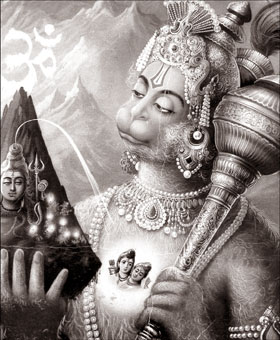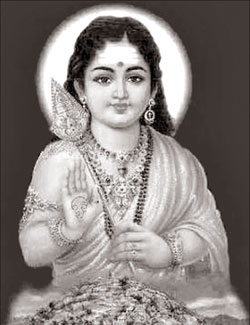|
HINDUISM
Sri Hanuman - embodiment of moral splendour
Chelvatamby Maniccavasagar
Our ancient Hindu culture has been known since time immemorial for
the spiritual wisdom, the knowledge about the higher dimension of the
human personality. Many a time in the past whenever this perennial river
of spiritual knowledge was showing signs of drying up due to exigencies
of historical condition, a great spiritual master appeared to rejuvenate
and replenish the springs of spirituality in the land.
|

Sri Hanuman |
Indeed, Gurudev Swami Chinmayananda stands in the forefront among the
great and glorious men who deluged the Holy Bharatha with spiritual
ideas.
Prompted by the inspiring faith in the divine, spontaneous unselfish
urge and truly voluntary effort combined with spell binding united
action cutting across religious denominations and political ideologies,
an idea to build a temple for Sri Hanuman (Anjenayar) came to the mind
of Gurudev Swami Chinmayananda when he visited Ramboda, a hamlet 4000
feet above the sea level surrounded by luscious tea estates in the
District of Nuwara Eliya.
This village is considered to be the place where Sri Hanuman set foot
in his search for Sita. Gurudev Swami Chinmayananda was tremendously
fascinated by the scenic beauty and serenity of the location that he
felt that the site was ideal for Sandeepam Lanka and Chin Maya Mission
of Sri Lanka with the consent and Blessings of Gurudev purchased a plot
of ten acres. “Swami Chinmayananda” named it “Ramboda” to signify its
association with Ramayana.
Even the former Minister S Thondaman donated a five acre plot to the
mission. He further provided at his cost, a motorable road to have
access to the temple.
With the blessings of Gurudev Pujya Swami Chinmayananda, the Hanuman
Temple at Ramboda was constructed when Pujya Guruji Swami Te Jomayanan
Daji was in October 1996.
In fact, D Eeswaran, Trustee of the Gintupitiya Murugan Temple, N
Somakanthan, Somasundaram and several others who were very much attached
to Chinmaya Mission took tremendous effort in constructing this temple.
Further, I have to mention here that Somakanthan, who was the Vice
President of Chinmaya Mission and ardent devotee of Gurudev
Chinmayananda Swami took an active interest in the establishment of the
Temple at Ramboda. Despite his heart condition, he worked very hard and
succeeded in making this kumbabishekam a great success. On his
initiative a quarterly bilingual journal titled “Voice of Chinmaya” was
published and he was the Editor of this Journal. His publications are
“Sri Lanka and Ramayanam” which contained research articles on ‘Sita
Eliya” Temple and the Temples of Siva in Sri Lanka, where Somakanthan
was the Executive Editor and Professor S Pathmanathan was the Chief
Editor. On the day of the Kumbabishekam of Hanuman Temple at Ramboda,
two books namely “Hanumantha Maharantham” and “Bhaktha Hanuman Katha”
written by Somakanthan were released. Further, Srimathy Padma Somakantha
played a very important role in not only forming the Bala Vihar classes
at Ramboda, but worked very closely with her husband in all his
activities.
“Bhaktha Hanuman is the embodiment of physical prowess, mental
spiritual, and intellectual uprightness, emotional balance and moral
splendour. As a devotee of Sri Rama, he asked Rama only one thing in
life,” Please give me this Blessing that “my affection for you should
never diminish.” As a great warrior, a great scholar, a sincere friend,
a Minister and as one wedded to truth, as servant and an outstanding
devotee Sri Hanuman exhibited the traits that no one has done in their
life time. Indeed, Sri Hanuman is one of perfection, a personification
of erudition, culture and efficiency. His strength was born out of
humility and his devotion to Lord Rama was pure and his whole life lent
itself into one white flame of faith and devotion. To him, the name of
Lord Rama was more potent than the Lord Himself.
Skanda Shasti fast
G Arulananthan
The world today is suffering from overspecialization in material
science and compartmentalization of knowledge and wisdom. Further, man
has completely forgotten his fundamental divine nature. As such, the
most urgent need of the hour is peace and love. Love brings unity of all
mankind and this unity combined with spiritual knowledge will
undoubtedly bring world peace.
|

God Muruga |
Peace is essential for eve ryone and that was the reason Swami
Vivekananda in his address to the Parliament of religions in America
said that man is a victim of his own desires and is caught up in his
passions of hatred and violence, thereby forgetting his inner spiritual
life of faith, love and harmony.
Skanda Shasti fast which is observed by Hindus for six days in
temples particularly in Murugan Temples will undoubtedly bring peace and
prosperity in our society which is overpowered by forces of darkness of
ignorance and egoistic arrogance, weighed down by trials and
tribulations, and conflicts and contradictions.
Skanda Shasti fast illustrates the conquer of evil forces by good
nature of human beings. The Demon by the name of “Suran” wanted to fight
with Lord Muruga. The Lord Muruga used his “Gnanavel” which symbolizes
knowledge and wisdom and conquered the “Demon Suran.”
In the “Puranas” good virtues are personified as Lord Muruga and the
Evil virtues are personified as Demon Suran. This is to illustrate to
the people the inner significance that the demonic desires, thought,
word and deed of the Demon have been defeated and it was a victory for
the good virtues.
Indeed, the Skanda Shasti fast is observed for six days with fervent
prayer, concentration and meditation of Lord Muruga. During this period
devotees generally abstain from food and after the pooja in the evening
they have meal of fruit, milk or coconut water. This fast is called
‘Upavasam’ which means drawing oneself close to God where the mind is
detached from the material world for spiritual progress.
This fast is observed at Kataragama Murugan Temple, Nallur Kandeswamy
Temple, Selvasannithi Temple at Thondamanaru, Arul Mighu Sivasubramaniya
Temple at Slave Island and various other Murugan Temple in Sri Lanka.
Further, on the sixth day of Skanda Shasti Fast there is a grand
festival called “Soorasamharam” which is enacted outside the Murugan
Temple. This is a battle between “Asuras” and “Skanda”. This battle is
between the animal-nature of man and his divine-nature culminating in
the final conquer of Ego by knowledge and wisdom.
The puranas extol Lord Muruga's legendary origin Devas when they
proceeded to Mount Kailas to complain to Lord Shiva of their persecution
by the Asuras, found him in deep meditation. On being awakened, a Divine
Spark emanated from his frontal third eye. This was received in lake “Saravanapoikai”.
There it was nurtured by constellation Pleiads (Karthikai) and became
six infants. They became one when they were fondly embraced by Divine
Mother Goddess Parvathy. Therefore, he is also known as “Karthikeya.”
Lord Muruga is said to have performed several brave deeds including
the imprisonment of Brahma. Before the battle, Lord Muruga sent
“Virapahu” as an emissary to persuade “Surapadman” to lay down arms and
release the Devas. But, “Surapadman” refused to lay down arms. Finally a
battle between “Surapadman” and Lord Muruga took place and ultimately
“Surapadman” was defeated, but was not slain. Surapadman accepted to
serve Muruga in the form of a peacock and he was also given a place in
Lord Muruga's banner as a Rooster Cock. Thereafter, the Devas were
released and they celebrated the victory. Indeed, the battle between
Lord Muruga and Asuras signifies a battle between ‘Divineself” and the
“Ego” in man.
To maintain peace, tranquility, serenity and equanimity we have to
get rid of desires and lead a life of detachment, faith and love. As
such, let us pray Lord Muruga and receive His Divine Blessings to lead a
peaceful life.
From tradition to modernity
K S Sivakumaran
One of the oldest languages in the world – Thamil is not dead and
still lives assimilating modernity. So is what is known as Hinduism.
Aspects of tradition and modernity are the key factors in keeping them
alive. This was evident in the recently concluded full three-day
research seminar organized by the Department of Hindu Culture and
Religious Affairs that come under the purview of the Prime Minister and
the Deputy Minister of the country.
Ably and farsightedly conceived by one of the eminent academics in
the country emeritus professor of history, Dr C Pathmanathan and
efficiently executed by the Department Head Shanthi Thirunavukkarasan
and her dedicated staff, the seminar was held at the Kolumbu Thamil
Sangam during 14, 15 and 16 of this month.
The topic of discussion under various heads in this year's seminar
was appropriately (Brithania Aaadchiyum Navvena Mayamaakalum) (The
Briitsh Rule (in Lanka) and Modernization). Eminent Indian, Malaysian
and Lankan scholars and academics mingled together and exchanged new
thoughts on various aspects of the findings in research on the main
theme.
The subjects chosen to be discussed varied from Mythology to
Modernity and indicate the framework within which Prof Pathmanathan and
other intellectuals designed the relevant subjects.
Let me list some of the subjects discussed for the benefit of the
readers.
Thamilology and Archaeology, Research on Inscriptions, Economic
changes under the British rule, The British rule and Nationalism,
Plantation Workers Settlement Plan and Malaysian Thamilians Living,
Social Change in British India, Dravidian Movement and Space for people
in India, Aarumuga Naavalar in Revival of Saivaism, State of Religion
during British Rule: From conflict to Compromise, Decolonizing British
Colonialism and Modernity in the backdrop of Hinduism, Aarumuga Naavalar,
Gandhism in Thamil Environment, Aravindiar, Ramanar, Ananda Coomaraswamy,
The Birth of Modern Literary Criticism in Thamil, Modernism, and Change
of thinking on Feminism in Lanka, Modernity in the contributions of
Christian Missionaries, The Role of Vallaar in the Formation of
Modernity in Religion and Society, Contribution by Sir John Woodraw in
the Efforts of Indian Tantric Practice, Institutions that tried to
preserve Traditional form of Education, The contributions by Hindu
Religious Institutions to the development of Lankan in Saivaism during
the British period, Modernity in the History of Publication of Thamil
Books, Modernism in the World of Publication in the context of the
contributions by C Y Thamotheampillai, Attempts in Lankan Publications
of Books, Efforts in Publication of Folk Literature in the 19th century,
Bharathi in the context of Trends in Thamil Literature, The Development
of Prose in Thamil Literature, The development of Thamil Poetry, Chennai
Lowkika Sangam in Revivalist Movements in Thamil Naadu in the 19th
century, The Development of Arts and Culture among Malaysian Indians
after the arrival of the Britishers, What Swami Vivekananda emphasized
on Decolonization and Modernity during British colonialism.
There were many other subjects discussed simultaneously in two
places. I mentioned above only what I witnessed.
This report would be incomplete without the names of the scholars who
participated as speakers. The list includes such eminent researchers as
C Pathmanathan, Pushpratnm, V Maheswaran, A Subbaryalu. R Muthiah,
Krishnan Maniam, V Arasu, B Gopala Krishna Iyer, K Raghuparan, S
Saravanan, Shanthi Naavatkarasan, Krishnaveni Nobert, K A
Sachithaanantham, S Thillainathn, K Panchangam, Chritralekha Munaguru, S
Jebanesan, Kalaivaani Ramanathan, S Mukunthan, E Kumaran, K Arunthavaraa,
ShriPrasanthan, S Sivalingarasa, Ammankili Murugadas, M A Nuhman, Thurai
Manoharan, K Muthiah, Kumaran Subramaniam, Saravanan, Dhammika
Jayasinghe, K Arunthakaran, M Vethanathan. Vigneswari Bavanesan, Shanthi
Kesavan, V Gunabalaingam, Nachchiar Selvanayagam, S Dushyanth, M
Rupavathanan, Mekala Sivakumaran, Suganthani Shri Muralidharan, Ruby
Valentina, C Selvarathnam, P Santhirasekeam, Anushya Senathirajah, S
Selvakumari, N Vaaman, K T Ganeshalingam, Sivagowri Sivagurunathan,
Anushya Sathiyaseelan, Meera Villavarayan, Saba Jeyarasa, S Jeyasangar,
C Maunaguru, S Yogarasa, Ramesh Abdullah and Vasantha Vaithianathan.It
was refreshing to attend these intellectual discourses in which the
audience too participated.
[email protected] |



